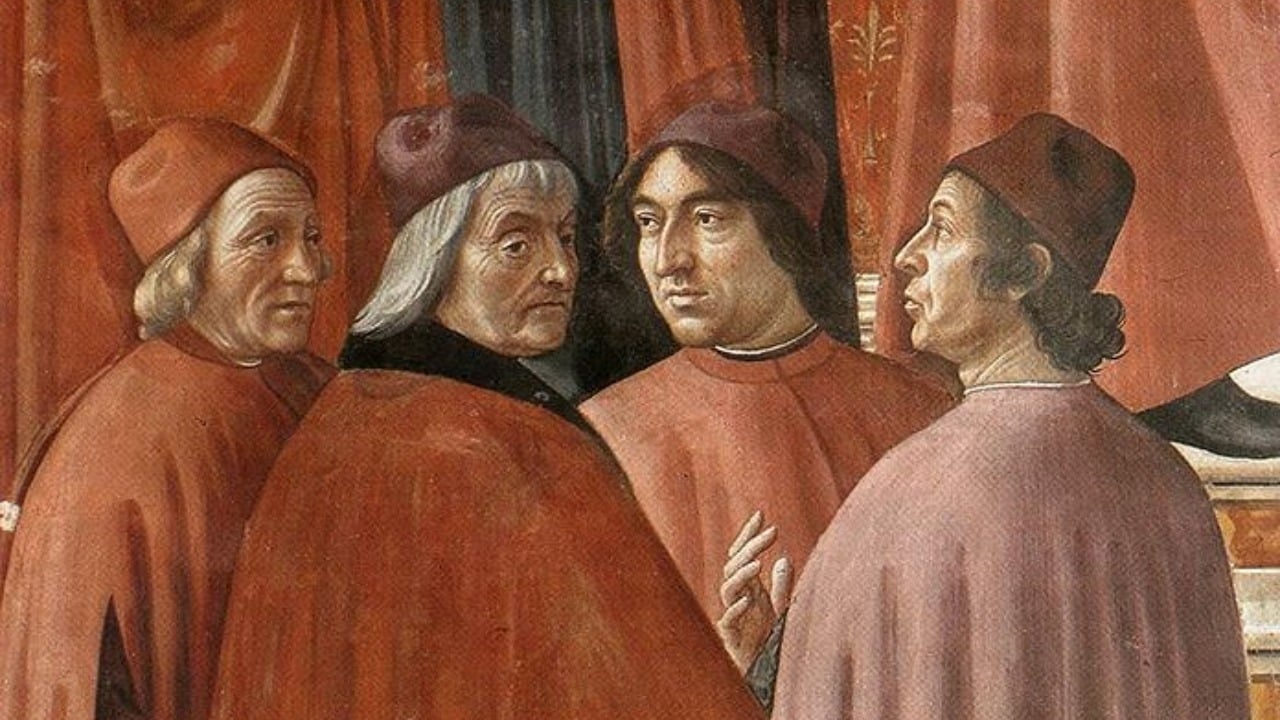
Between the 14th and 15th centuries, a wave of Greek scholars left their beleaguered homeland in the Byzantine Empire for the Italian Peninsula, where their work would play an important role in the flowering of the Renaissance.
The Renaissance, which literally means “rebirth”, was a period usually identified as lasting between the 14th and 17th centuries. It was characterized by an increased interest in the Greek and Roman past, with the scholars of the time looking back to Classical civilization for inspiration in the arts and sciences.
When the Byzantine Greek scholars arrived in Italy, they brought centuries of knowledge from Greco-Roman civilization with them. Medieval Italian scholars had already taken an interest in Classical Roman civilization, but this new wave of Byzantine intellectuals were well versed in ancient Greek sources and greatly widened the scope of the academic and artistic endeavors that were then possible.
The Byzantine Greek contribution to the Renaissance
The Byzantine Empire is often overlooked for its contributions to philosophy, science, and the arts, but without the influence of this enigmatic civilization, the Renaissance would not have achieved the heights of human achievement it has since become renowned for.
As Byzantine power waned and eventually collapsed entirely under the stress of the Ottoman invasions, many of its best and brightest thinkers left for safer shores. The majority of these Byzantine Greek scholars arrived in Italy, where they would make important contributions during the Renaissance period.
The influence of these scholars was diverse and wide ranging, especially as far as the transfer of ancient Greek knowledge to a larger European audience was concerned.
For example, Leonardo Bruni, the preeminent humanist philosopher and historian of his time, was influenced by the philosophy of Aristotle and Plato, whereas the brilliant Leonardo da Vinci drew inspiration from ancient Greek medical practitioners like Galen for his anatomical studies.
Manuel Chrysoloras (c. 1350 – 1415)
Manuel Chrysoloras was an influential Byzantine Greek teacher and diplomat, and a personal friend of the Byzantine emperor Manuel II Palaiologos. He first visited Italy during the 1390s as a diplomat to win over Western military support against the Ottoman Empire.
However, in 1397, he left Constantinople again to take up a new position as a professor in Florence at the behest of Coluccio Salutati, the most prominent political figure in the city until the rise of the Medici.
Chrysoloras was widely celebrated by his Italian peers for bringing Greek scholarship to Italy. In fact, the aforementioned Leonardo Bruni made the exaggerated claim that he had brought back the study of Greek to Italy for the first time in seven centuries.
His most important works were a Comparison of the Old and New Rome, wherein he compared Constantinople and Rome, and a Greek grammar textbook titled Erotemata (Questions).
Chrysoloras counted many prominent names among his pupils, including Poggio Bracciolini, Leonardo Bruni, Guarino da Verona, Carlo Marsuppini, Niccolò Niccoli, Palla Strozzi, and Pier Paolo Vergerio the Elder.
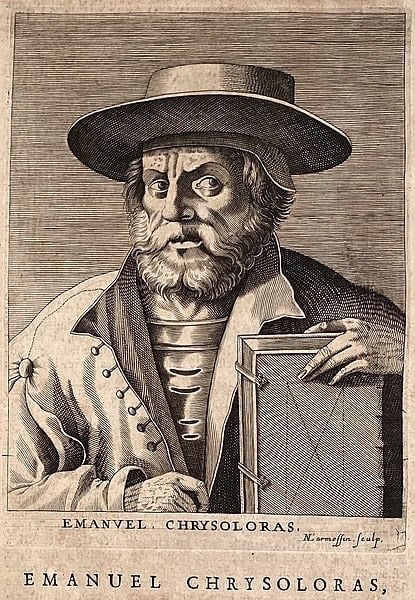
Georgios Gemistos Plethon (1344 – c. 1452)
Georgios Gemistos Plethon was one of the foremost Greek scholars of the late Byzantine period and is most renowned for reintroducing Plato’s ideas to Italy and Western Europe. In fact, he adopted the surname of Plethon as a deliberate homage to Plato.
Plethon spent most of his life in Mystra in the Despotate of Morea in the southern Peloponnese, where he had been sent by the Byzantine Emperor Manuel II Palaiologos. However, Plethon spent a brief but influential time as a tutor in Italy, where he had the chance to introduce his pupils to the most important thinkers of antiquity.
In 1438, Byzantine Emperor John VIII Palaiologos invited Plethon to attend the Council of Ferrara – later known as the Council of Florence – to discuss the unification of the Greek and Latin Churches. A number of his students joined him at the council, including Bessarion, Gennadius Scholarius, and Mark Eugenikos.
Just one year later, Plethon was invited by a group of Florentine humanists to teach in their city. During his time in Florence, he delivered lectures on Platonic teachings and wrote the volume Wherein Aristotle disagrees with Plato, during a bout of sickness.
The Greek scholar only taught in Florence between 1439 and 1440 but his impact on the developing Renaissance was profound. He helped popularize the study of Plato in Italy whereas before only Aristotle had been relatively well known.
The immensely powerful Florentine banker and politician Cosimo de’ Medici may even have been inspired to found and patronize the Accademia Platonica after attending Plethon’s lectures.
Plethon died in either 1452 or 1454, so it is not known whether he would have been alive to hear of the fall of Constantinople in 1453. In any case, his reputation endured after his death to such an extent that even his remains were sought after. During a military campaign in the Peloponnese between 1464 and 1466, Sigismondo Pandolfo Malatesta, one of the greatest generals of the Italian Renaissance, stole the remains of the Greek scholar and brought them back to Italy, where he interred them at the Tempio Malatestiano in Rimini.
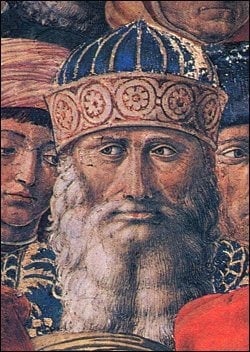
Portrait of Georgios Gemistos Plethon, detail of a fresco by acquaintance Benozzo Gozzoli, Palazzo Medici Riccardi, Florence, Italy. Credit: Benozzo Gozzoli / Public domain / Wikimedia Commons
Theodorus Gaza (1398 – c. 1478)
Theodorus Gaza was one of the most prolific Greek professors active in Italy during the Renaissance. He was originally from Thessaloniki but fled to Italy in 1430 after the city’s final fall to the Ottoman Turks.
He was appointed as a professor of Greek at the recently established University of Ferrara in 1447. His reputation as an outstanding teacher attracted a large number of students from various parts of Italy. Among his pupils in Ferrara was Rodolphus Agricola.
Unlike Plethon, who venerated the teachings of Plato, Gaza favored the works of Aristotle, and contributed immensely to the philosophical defense of Aristotelianism during the debates of the 15th century.
In 1450, he was invited by Pope Nicholas V to translate the works of Aristotle, Theophrastus, and other ancient scholars from Greek into Latin.
After the death of Nicholas V, Gaza relocated to Naples where he enjoyed the patronage of King Alfonso the Magnanimous between 1456 to 1458. He spent the remainder of his years living in Calabria and was buried in the Basilian monastery of San Giovanni a Piro around the years 1477 or 1478.
After his death, the Italian Renaissance scholar Ermolao Barbaro wrote a letter to Pope Sixtus IV in praise of his Greek contemporary.
“That Greek man outdid all Latins in the task of writing and translating. If he had lived longer, he would have enriched the Latin language in this field as well. He did that indeed in those most perfect books of Aristotle’s On Animals and Theophrastus’ On Plants. In my view, he is the only one to challenge antiquity itself.”
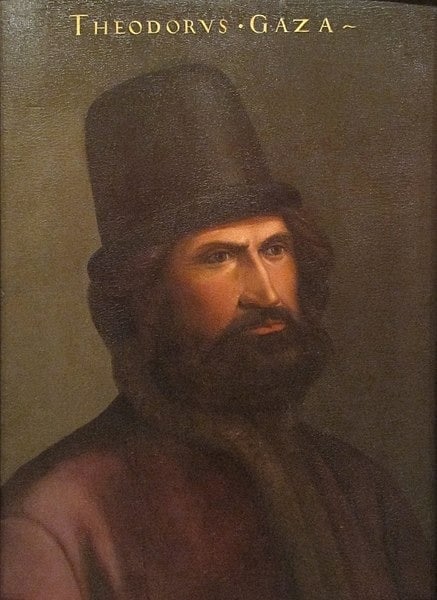
Ioannis Argyropoulos (1415 – 1487)
Ioannis (John) Argyropoulos was another great Greek scholar, lecturer, and humanist philosopher during the Renaissance. Like Plethon and other notable Byzantine scholars of the time, he attended the Council of Florence.
Argyropoulos studied Theology and Philosophy in Constantinople where he would also teach for a time after completing his studies. One of his pupils, Constantine Lascaris, would also one day teach in Italy and contribute to the Greek revival of the Renaissance.
After the fall of Constantinople in 1453 Argyropoulos fled to the Peloponnese, before relocating again to Italy in 1456. He had already received a a Doctor of Theology degree from the University of Padua during previous travels to Italy years before the fall of the Byzantine capital.
Argyropoulos soon found a scholarly position in Italy and was made the head of the Greek department at Florence’s Florentine Studium. In 1471 however, the city of Florence was gripped in the deadly clutches of the plague, and he decided to move again to Rome where he continued to teach until his death.
The most famous pupil of Argyropoulos was the famed polymath Leonardo da Vinci. He also taught the influential Florentine statesmen and bankers Pietro de’ Medici and Lorenzo de’ Medici; the Italian classical scholar and poet Angelo Poliziano; the German humansit and scholar Johann Reuchlin; and Jacques Lefèvre d’Étaples, a French humanist and theologian.
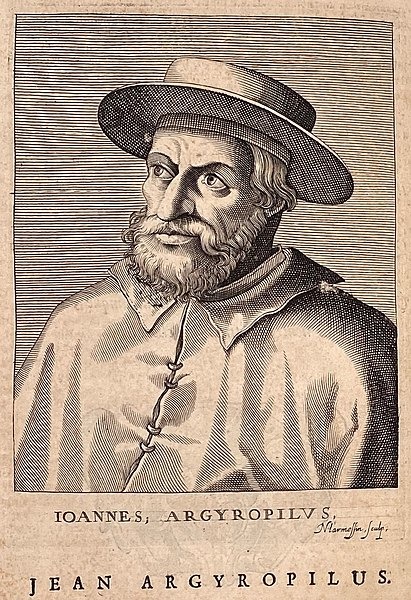
Demetrios Chalkokondyles (1423 – 1511)
Demetrios Chalkokondyles taught Greek literature prolifically at the most renowned universities of Renaissance Italy, including Padua, Florence, and Milan. He was originally from Athens and lived for a time in the Peloponnese before permanently relocating to Italy in 1447.
He arrived in Rome in 1449 and was tutored by his fellow Greek scholar Theodorus Gaza. A while later Chalkokondyles impressed Lorenzo de’ Medici with his ability to bring Greek Classical literature alive and was appointed to teach Medici’s sons.
In 1463, Chalkokondyles became a professor at Padua before taking over from John Argyropoulos as the head of the Greek Literature department in Florence in 1479. It was during his tenure at Florence that he completed his most important work, an edited edition of Homer’s work.
Chalkokondyles was the first person to publish printed editions of the works of Homer, Isocrates, and the Suda Lexicon. The printing press had been invented in the 1430s in Germany, finally arriving in Italy in 1465. Chalkokondyles published the first printed edition of Homer’s work in 1488.
He was pained greatly by the fall of Constantinople and was an outspoken campaigner for the liberation of his native Greece from the Ottoman Turks. In the decades after the fall of the Byzantine capital, Chalkokondyles tried to rally support from Venice and the other Italian centers of power for a counter invasion to expel the Ottomans from his homeland.
Despite marrying at the late age of 61 in 1484, Chalkokondyles sired 10 children over the course of his marriage. He spent his final years tutoring in Milan after being invited there by Duke Ludovico Sforza.

See all the latest news from Greece and the world at Greekreporter.com. Contact our newsroom to report an update or send your story, photos and videos. Follow GR on Google News and subscribe here to our daily email!



